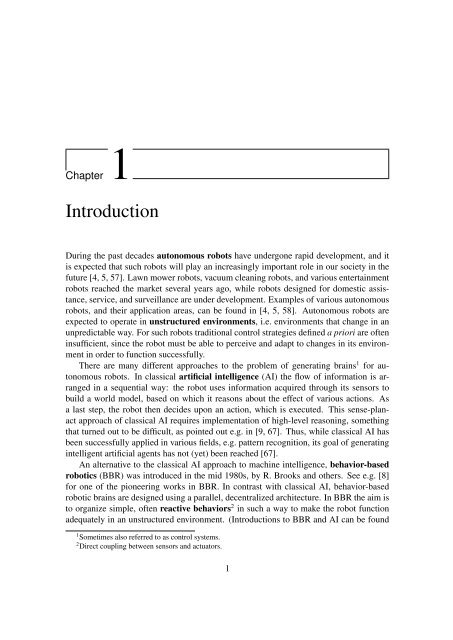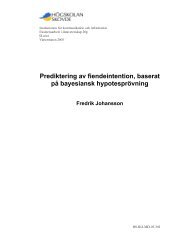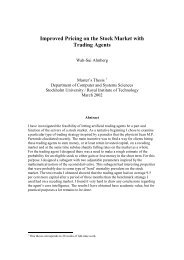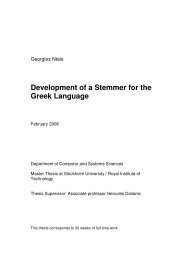Modeling Hydra Behavior Using Methods Founded in Behavior-Based Robotics
Modeling Hydra Behavior Using Methods Founded in ... - SAIS
Modeling Hydra Behavior Using Methods Founded in ... - SAIS
Create successful ePaper yourself
Turn your PDF publications into a flip-book with our unique Google optimized e-Paper software.
Chapter 1IntroductionDur<strong>in</strong>g the past decades autonomous robots have undergone rapid development, and itis expected that such robots will play an <strong>in</strong>creas<strong>in</strong>gly important role <strong>in</strong> our society <strong>in</strong> thefuture [4, 5, 57]. Lawn mower robots, vacuum clean<strong>in</strong>g robots, and various enterta<strong>in</strong>mentrobots reached the market several years ago, while robots designed for domestic assistance,service, and surveillance are under development. Examples of various autonomousrobots, and their application areas, can be found <strong>in</strong> [4, 5, 58]. Autonomous robots areexpected to operate <strong>in</strong> unstructured environments, i.e. environments that change <strong>in</strong> anunpredictable way. For such robots traditional control strategies def<strong>in</strong>ed a priori are often<strong>in</strong>sufficient, s<strong>in</strong>ce the robot must be able to perceive and adapt to changes <strong>in</strong> its environment<strong>in</strong> order to function successfully.There are many different approaches to the problem of generat<strong>in</strong>g bra<strong>in</strong>s 1 for autonomousrobots. In classical artificial <strong>in</strong>telligence (AI) the flow of <strong>in</strong>formation is arranged<strong>in</strong> a sequential way: the robot uses <strong>in</strong>formation acquired through its sensors tobuild a world model, based on which it reasons about the effect of various actions. Asa last step, the robot then decides upon an action, which is executed. This sense-planactapproach of classical AI requires implementation of high-level reason<strong>in</strong>g, someth<strong>in</strong>gthat turned out to be difficult, as po<strong>in</strong>ted out e.g. <strong>in</strong> [9, 67]. Thus, while classical AI hasbeen successfully applied <strong>in</strong> various fields, e.g. pattern recognition, its goal of generat<strong>in</strong>g<strong>in</strong>telligent artificial agents has not (yet) been reached [67].An alternative to the classical AI approach to mach<strong>in</strong>e <strong>in</strong>telligence, behavior-basedrobotics (BBR) was <strong>in</strong>troduced <strong>in</strong> the mid 1980s, by R. Brooks and others. See e.g. [8]for one of the pioneer<strong>in</strong>g works <strong>in</strong> BBR. In contrast with classical AI, behavior-basedrobotic bra<strong>in</strong>s are designed us<strong>in</strong>g a parallel, decentralized architecture. In BBR the aim isto organize simple, often reactive behaviors 2 <strong>in</strong> such a way to make the robot functionadequately <strong>in</strong> an unstructured environment. (Introductions to BBR and AI can be found1 Sometimes also referred to as control systems.2 Direct coupl<strong>in</strong>g between sensors and actuators.1





